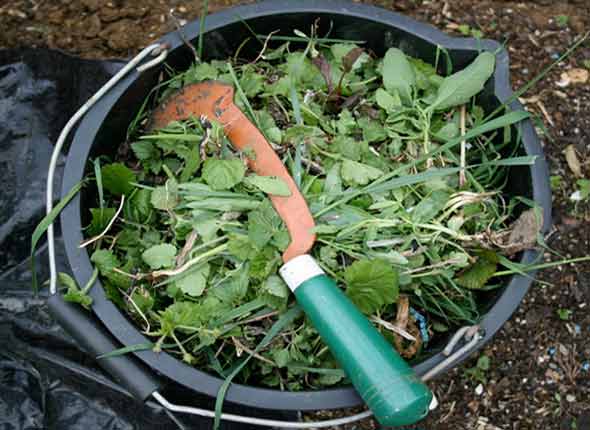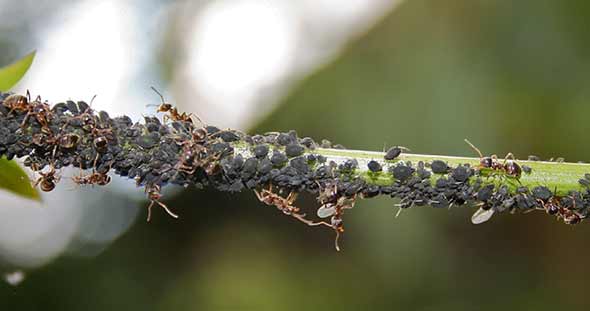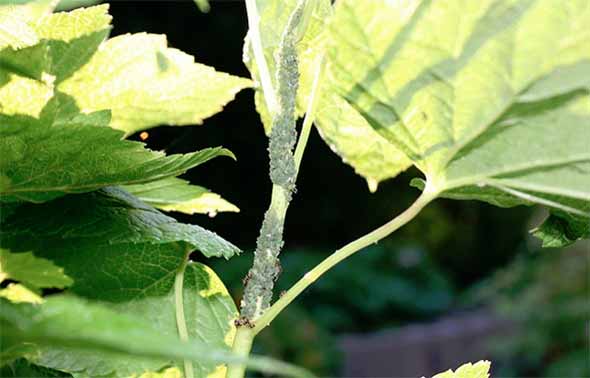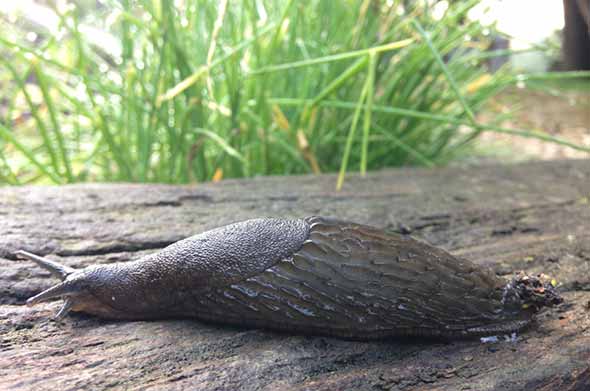No gardener likes to see their perfect crops being blemished – or even eaten to the ground – by pests. Diverse planting helps to confuse pests and welcome in beneficial wildlife, and in an organic garden the aim is to create an ecosystem that is in balance, so that when pests attack they are quickly dealt with by predators. If the soil is in good health, and your plants aren’t stressed, then your pest problems should be minimal, but there’s always a chance that some will arise.
The best solution is the gardener’s presence in the garden. The more time you spend outside, with your plants, then the quicker you will notice when something is amiss. If you do see pests on your plants then the first course of action shouldn’t be to reach for something to kill them, but to stop and investigate the situation. Is the plant stressed – does it need feeding or watering? Or has it been overfed, producing too much soft and sappy growth? Are nearby weeds harbouring pests, and can they be removed?
If the garden is healthy then a small population of pests can be left alone to begin with. Give the predators time to find the pests, and once they do they will do the hard work of keeping them under control for you. If you keep depriving the predators of their food source, they won’t stay in your garden.
You can quickly dispose of small populations by hand picking them off (or squashing small bugs under your thumb), and keep a watchful eye to see whether the problem reoccurs. If you have the hosepipe out then a quick blast of water is often enough to dislodge some pests without damaging plants. By the time the pests regroup, the predators may well have arrived.
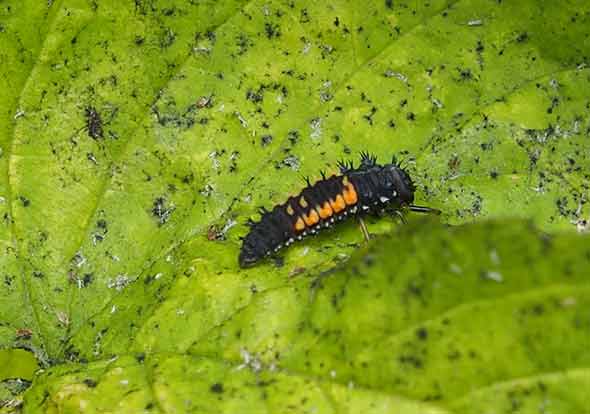 Ladybird larvae are beneficial.
Ladybird larvae are beneficial.
One of the most important things to consider is whether you have correctly identified a pest. Ladybird larvae, for example, look quite exotic and scary – but they’re entirely beneficial to plants as they feed on aphids. Wood lice get the blame for damaging harvests, but in reality they are only there as a result of prior damage (usually by slugs or snails) as they feed on rotting plant tissue. If there are creatures present that aren’t causing any issues, then leave them be and maintain the balance in your garden.
With that in mind, here’s a round-up of the common pests in vegetable gardens, with some ideas on how to deal with problems if they arise.
Ants are generally more of a problem for humans than they are for plants – we really don’t like it when they come inside the house! But ants have two habits that are damaging to plants. Firstly, they build quite extensive nests in dry soil, and their tunnels make the soil very free draining. Often more of an issue in pots than in open soil, what you can find is that a plant attempting to grow over an ants’ nest will always be thirsty.
A quick fix is to water the plant well and then stand the pot in a tray of water for a couple of hours. With their home waterlogged, the ants will move on. Alternatively, repot the plant in fresh compost and keep it well watered for a few days while it settles back in. I used to tip ants’ nests out for my chickens to have a go at. One of them loved eating ants, and ant cocoons were a favourite food for the other. Between the two of them they demolished a nest in no time!
The other thing ants do that makes them more of a problem in the garden is that they farm aphids. Aphids produce a sweet, sticky secretion that ants like to eat. If ants find a population of aphids on a plant they will defend it from predators, and they can also carry aphids to different parts of the plant (or to different plants entirely) in order to grow the aphid population. The solution here is to deal with the aphids, rather than the ants.
There are more than 500 species of aphid in the UK, all sap-sucking insects that feed on plants and can also spread viruses and other plant diseases. They breed very rapidly, meaning that a large population can build up when your back is turned. The sticky residue they produce is also the perfect host for sooty moulds, and that may be the first symptom that you spot.
On the other hand, aphids and blackfly are a food source for a lot of beneficial wildlife, from lacewing larvae and ladybirds all the way up small birds. If you have a bird feeder in your garden then you may see that birds are busy among your plants whilst they “wait their turn” on the feeder, and they will be looking out for aphids and other bugs that they can eat.
If you have ladybirds in your garden then you can gently move them onto plants affected by aphids. You don’t need to plonk them right into the midst of the aphids, they will climb the plant and find their own way. You can even buy ladybird larvae (voracious aphid eaters) as a biological control, but a healthy garden will develop its own population.
So you don’t want to completely eradicate aphids, as then the ladybirds will also move on. A small population can be quickly rubbed off with your fingers, or blasted off with the hosepipe. This won’t kill them all, and they will continue to breed, but you’re just giving the local predator population time to move in.
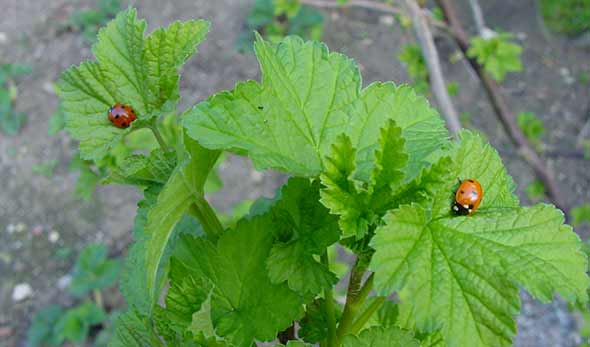 Ladybirds will climb bushes and eat aphids.
Ladybirds will climb bushes and eat aphids.
A larger problem can be dealt with either by an eco-friendly spray based on fatty acids, or a soft soap solution. This will kill off the aphids, but won’t hurt beneficial insects, and they’re easy to use as you don’t have to worry about getting them on yourself, either. Check for the presence of predators such as ladybirds before you start spraying – if they’ve moved in they will deal with the problem and you can simply monitor their progress.
Blackfly tend to me more of a problem in some years than others. Pinching out the tops of your broad beans is standard advice to prevent an infection there, and elsewhere they are treated in the same way as aphids.
Birds can be both friend and foe in the garden. We love watching their antics, and they do a lot of good work eating pests and adding little packets of fertility to the soil! However, they can be a problem when they start eating the plants, and unfortunately here the only real solution is to protect the plants. So if the pigeons have taken a liking to your winter brassicas then it’s time to net them if you want to save some to harvest yourself. And a fruit cage is the best way to protect your fruit crops, although it brings its own problems as you need to check regularly whether any birds or small mammals have got themselves trapped in the netting.
There are various other options to deter birds, products that make a noise or flashes of light, or mimic a bird of prey. Birds get wise to them quite quickly, so for them to remain effective you need to mix them up and move them to new locations in the garden. Please do think of your neighbours before you invest in anything too noisy!
Of course, you could get a cat to keep birds out of the garden, although you may then find that your moggy is of the murderous variety, and kills wild birds – and wild bird populations can use all the help they can get. If your neighbours have cats then you’re likely to discover the other ways in which they can be pests in the garden. They have a habit of squashing plants (particularly seedlings) as they roll about. And they leave presents. Nasty, unwanted, unhealthy and stinky presents. Cats like to do their business in soft, bare soil, so that they can bury it. However, they don’t make much of an attempt to bury it – just enough to keep it from being immediately obvious. You’ll know when a cat has used your garden as a toilet, as you’ll smell it. But it may take you some time to locate the actual site.
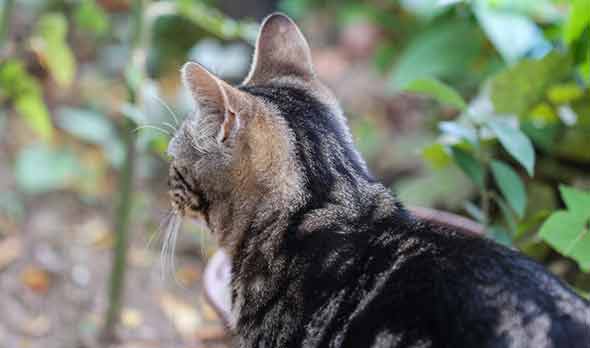
Defending plants from being squashed is tricky, but the key to preventing unwanted gifts is knowing what cats like. As I said, they love bare soil, so keep soil covered with a mulch when it isn’t planted. Use prickly branches to protect a seed bed – cats have soft paws and soft behinds, and won’t walk or squat on a prickly surface. Brambles are ideal, and can be removed later on when the plants are larger and the soil is covered.
Cats apparently locate their toilets via smell, so if you have had to clear up a mess then it helps to cover up the smell. Citrus peel is one option, coffee grounds are another. You can buy proprietary cat deterrent products, but if they’re based on smell then they wear off quite quickly and will definitely need reapplying after rain. If you’re a proper coffee drinker then regular applications of coffee grounds will do the trick, add nutrients to the soil, and leave your garden with a delectable smell!
Tall fencing keeps out pampered pussies that have got too fat to climb, but if you have a real cat problem then electronic scarers are the most efficient defence. They have passive infrared detectors to detect animals, and normally blast out a frequency that is too high for human hearing, but is painful for cats (and dogs, and foxes). If it’s not wired into the mains then you need to keep checking the batteries – the cats will return just as soon as they run out. Cats are wily and love to outsmart their human nemesis, so they are tricky to deal with once and for all. Of course, you could always get a dog….
After pigeons, the biggest problem for brassicas (cabbages, kale, broccoli, Brussels sprouts, even nasturtiums) are the dreaded cabbage whites. It’s not the butterflies that are the problem – it’s their caterpillars.
There are two problematic species, large cabbage whites and small cabbage whites. One has green caterpillars, and the others are brown and patterned. The problem, and the solution, is the same. To prevent them from eating their way through your brassica harvest you either have to stop the butterflies from reaching the plants (with a suitably small gauge insect mesh) or you have to remove the yellow eggs and the caterpillars by hand. Eggs are laid on the underside of leaves, either singly or in small groups. The caterpillars will be hiding out as deep into the plant as they can get; you’ll probably notice either the results of their chomping first, or their black frass (poo). If you don’t net your brassicas then you need to check plants over carefully every couple of days for eggs and caterpillars.
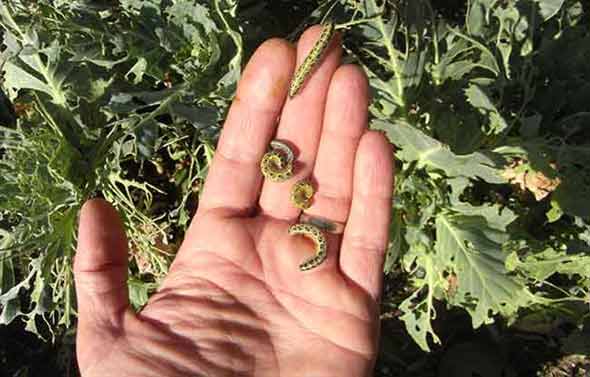
The damage caused by cabbage white caterpillars is significant!
If you do net the plants then you do need to keep checking that that they haven’t grown to the point where they’re pressing up against the net, where the butterflies can reach them. Or you could do what they did during World War 2, and send the kids out to whack the butterflies with tennis rackets, but they’re a problem right through the growing season.
I have only ever met one gardener who didn’t have problems with slugs and snails, and his garden (in the Netherlands) was surrounded on all sides by water. Even roof gardens have problems with snails (which can really climb!), and it’s easy to import slug eggs in plants and compost. However, every organism in the garden has a role to play, and slugs and snails are food for wildlife and do important work helping to break down rotting plant matter. They’re only an issue when they’re chomping through things you want to eat, or sawing off the tops of seedlings in the middle of the night. Then it’s war.
Slug traps entice them in with the promise of a beery treat – simply put the dregs of your beer into a yoghurt pot or similar container, and bury it in the soil. Make sure the top of the pot is above the soil surface. Slugs and snails will climb in (and drown), but you don’t want beneficial creatures such as beetles to fall in on their way past. Check daily and dispose of the bloated remains before they get really nasty.
Avoid using salt anywhere near plants and soil – it’s poisonous to them as well. There’s a reason invading armies used to salt the fields as they marched past, it renders them useless for growing crops for some time.
Barriers are another option. Anything that is prickly or sucks up moisture can stop slimy creatures in their tracks – you can buy Slug Stoppa granules, or use oatmeal or anything prickly. Check after rain to make sure the barrier is still intact. Copper tape is good around pots, and you can get copper mats for them to sit on. Some people recommend using copper tools for general garden work. Others go on nightly, torch-lit hunts and chop up marauding slugs with their secateurs!
There isn’t one thing that will stop all slugs and snails all of the time in any garden – and that’s a good thing, as wiping out a section of the ecosystem is a bad idea. Experiment to find what works for you, and in a bad year consider investing in the biological control, which is watered in a couple of times during the season.
Oh, the evil weevil, scourge of pot-grown plants across the country. The adults look quite comical, with their long snouts and big feet. They don’t do much damage, but their larval offspring eat their way through plant roots and can easily kill both seedlings and mature plants. If you see the adults it’s a good bet that the larvae are also present.
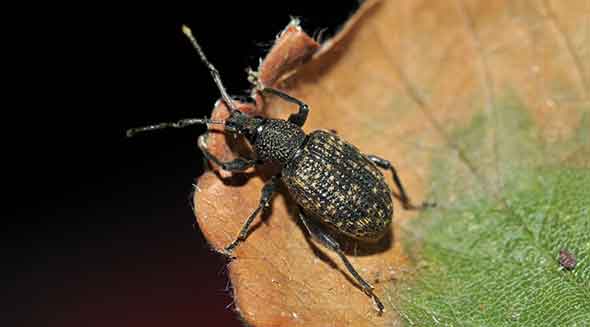
There is no chemical control approved for use on edible crops, but there is a biological control you can use when the weather is right. Kill adults on sight (but do make sure you have correctly identified them – there’s more than one sort of weevil!) and check the soil in neighbouring pots to see whether the larvae are present. These white grubs are easily spotted and removed.
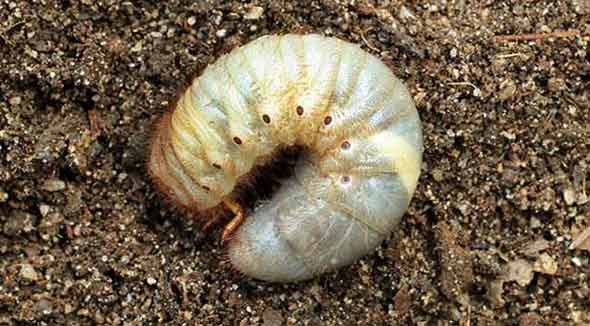
I find that a layer of newspaper across the drainage holes at the bottom of pots does offer a barrier to vine weevils, although it gradually rots down and is only really good for one year. An old cotton tea towel or t-shirt would offer longer-term protection, whilst still allowing water to drain out of the pot.
When everything fails and you’re facing the loss of a crop to a pest, it pays to be slightly philosophical about it – we’re trying to work with nature rather than against her, and sometimes she has different ideas! Ponder where you can be more welcoming to beneficial wildlife, or where your soil needs building up, and plan to plant a little more diversely next year. Then find a similarly affected garden neighbour who can commiserate over a cup of tea and a slice of cake, or even a pint!

